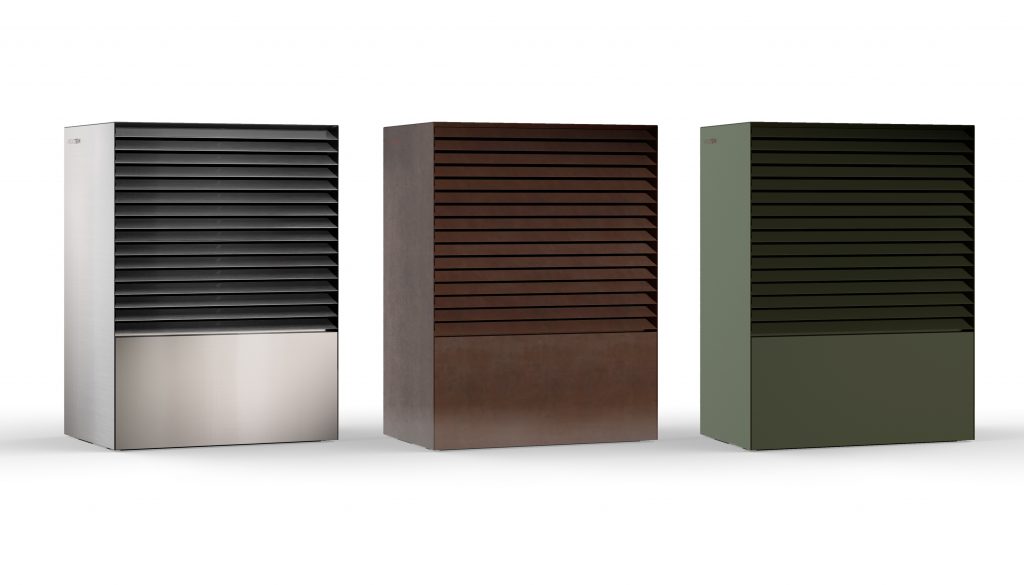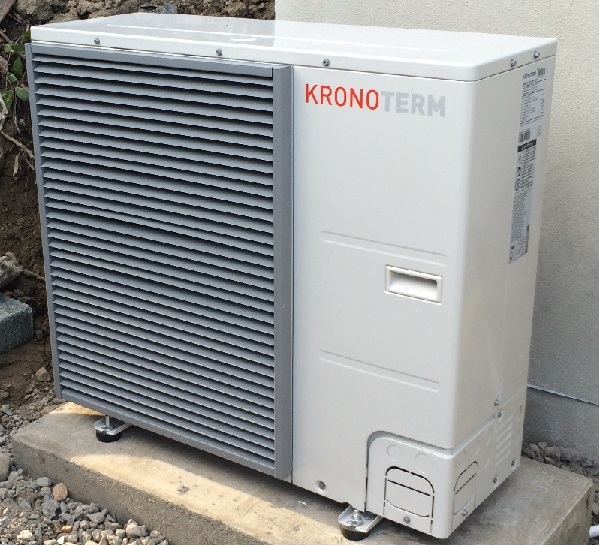What are Heat Pumps?
Heat pumps are the heating system of the future for Ireland. They are more efficient, cheaper to run and importantly are the cleanest heating system available. Heat pumps emit the lowest greenhouse emissions compared to all other heating systems. But what exactly are they?
Heat pumps are central heating systems that are extremely efficient and so cost very little to run. Simply put, a heat pump is a fridge that works in reverse. If you put your hand behind a fridge you will feel that it is warm – the heat has been taken out of your fridge and put into the kitchen, cooling the interior of the fridge and warming up your kitchen. A heat pump does the same thing but on a larger scale, it takes the heat from the air or ground (or water..) outside and transfers it inside a building. In Ireland we typically use Air to Water heat pumps which use the Air as the primary source of renewable heat.

A grant for the installation of heat pumps has been available from SEAI from April 2018. The heat pump grant will apply to houses built before 2006 and will be worth €3500. Further details are here. If you are interested in receiving more information on this grant for heat pumps please drop us an email here and we will reply with further options on how to get a heat pump installed in your house or building.

Air To Water Heat Pumps
Ireland has a very temperate climate and so does not experience very cold Winters as a rule – outside temperatures rarely fall below -3 deg C in winter and for the most part stay above zero. Because of this Air to water heat pumps perform extremely well in Ireland. Air to water heat pumps provide heat by using the outside temperature to turn a refrigerant liquid into a gas which is then compressed. When a gas is compressed it exerts heat, this heat is then used to heat your home or building. The main benefit of an air to water heat pump to a home owner is very high efficiency resulting in low heating costs and low greenhouse gas emissions.
How do Heat Pumps Work
To extract the heat from the air air to water heat pumps have an outside heat exchanger unit called an evaporator. This looks a little like a car radiator with lots of fins but instead of expelling heat to the air it takes heat from the air. The air is moved through the heat pump’s evaporator by a fan whenever the heat pump is on. The heat pump’s evaporator runs a refrigerant liquid through it which boils at a very low temperature. Air to water heat pumps can heat your house or building even when it is as cold as -15 degC outside.
This refrigerant is then compressed or ‘pumped up’ to a higher temperature by the compressor just like in your fridge. This heat is then passed to the water that circulates around through your radiators or underfloor heating to heat your house.
Heat pumps use electricity to run the compressor which creates the heat, but the amount of electricity is very low when compared to Oil or gas or direct electric heating systems. For every 1 unit of electricity that is used by our heat pumps they produce 4 -5 units of heat. The Kronoterm ADAPT heat pump can produce an incredible 5.6 units of heat from one unit of electricity!
Heat pumps work best heating underfloor heating but can just as easily heat radiators that are sized a little bit bigger. Heat pumps can also heat your hot water for showers and sink water.
Air To Water Heat Pump Types
There are three main types of air to water heat pumps, split systems, mono block heat pumps mainly for space heating and/or water heating combined and thirdly hot water heat pumps specifically for hot water production for showers, taps etc…
Split System Heat Pumps
A split system air to water heat pump consists of an outside unit with the fan and evaporator and an indoor unit with pumps and compressors etc. The two units are connected by refrigerant pipes. The outdoor unit extracts the heat from the air and passes this heat energy to the refrigerant in the system. The refrigerant is compressed up to a high temperature and is circulated to the indoor unit which has a heat exchanger which takes the high temperature heat from the refrigerant and passes it to the water that circulates to the heating and hot water system. These systems can be highly efficient. Our Kronoterm WPLV-09 heat pumps are a good example of this. More Info on these systems is here: SPLIT SYSTEM HEAT PUMPS
Mono Block Heat Pumps
A mono block air to water heat pump consists of a single outside unit that contains the air to refrigerant evaporator, the compressor and the heat exchanger. In mono block heat pumps all the heat production and exchange occurs outside, the heat is extracted from the air and passed to the refrigerant, the refrigerant is compressed up to a higher temperature and the heat from the refrigerant is passed to the water that circulates to the heating and hot water system. This outside mono block unit is connected into your house or building by means of two water pipes similar to an outside boiler system. Toshiba CIAT heat pumps are a good example of this kind of system. More info on these systems is here: MONO BLOCK HEAT PUMPS
Hot Water Heat Pumps
Hot water heat pumps are specifically designed to produce domestic hot water for showers, taps, washing etc.. Standard air to water heat pumps drop in efficiency when producing hot water due to the high temperatures required but hot water heat pumps use waste air inside a building to produce the heat which can double the efficiency. More info on these heat pumps is here: HOT WATER HEAT PUMPS
Dairy Farm Heat Pumps
Dairy farms use a lot of hot water for washing equipment so hot water heat pumps are ideal for dairy farms as they produce hot water at the cheapest rate available. Glenergy supply a hot water heat pump specifically suited for ruse on Dairy Farms. More info on these heat pumps is here: DAIRY FARM HEAT PUMPS
Heat Pumps – Part of a System
Heat pumps are fantastic at providing heat for space and water heating and they also marry well with other energy technologies provided by Glenergy. For example by combining heat pumps and solar panels you can produce an equivalent amount of electricity that the heat pumps will use so you are effectively getting a free heating system. See below for a video testimonial from one of Glenergy’s previous customers who combined space heating heat pumps with hot water heat pumps, underfloor heating and solar panels.
